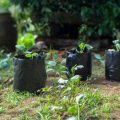1. Understanding the Importance of Organic Weed Management
Weeds are a common challenge in every garden, but how we manage them makes all the difference. Choosing organic methods for weed control is about more than just avoiding chemicals—its a commitment to creating a healthier, more sustainable environment right in your backyard.
Why Go Organic?
Conventional herbicides can be harmful not only to weeds but also to beneficial insects, soil life, and even our health. Organic weed management focuses on natural methods that support the entire garden ecosystem. Heres why its worth considering:
| Benefit | Description |
|---|---|
| Soil Health | Organic practices avoid synthetic chemicals that can damage soil microbes. Healthy soil promotes stronger plants and better water retention. |
| Pollinator Protection | Chemical herbicides may harm bees, butterflies, and other pollinators. Natural weed control keeps these vital creatures safe. |
| Sustainable Gardening | Organic weed management supports long-term garden health by working with nature rather than against it. |
The Big Picture
Using natural methods helps maintain balance in your garden. When you pull weeds by hand, use mulch, or encourage ground cover plants, youre not just removing unwanted growth—youre building a stronger, more self-sustaining environment for everything else to thrive.
A Garden That Gives Back
An organic approach to weed control doesnt just make your garden look better—it contributes to cleaner water, healthier air, and a safer space for pets and kids to play. Its a small change that leads to big results over time.
2. Identifying Common Garden Weeds and Their Growth Patterns
To manage weeds organically, the first step is knowing what youre up against. Across the U.S., a variety of common garden weeds thrive in different climates and seasons. By learning to recognize these weeds and understanding their growth habits, you can take timely action to prevent them from taking over your garden.
Understanding Weed Life Cycles
Weeds grow in cycles—some pop up annually, while others come back year after year. Knowing their life cycle helps you decide when to remove or suppress them most effectively.
| Weed Type | Life Cycle | Common Growth Season |
|---|---|---|
| Annual | Completes life in one season | Spring to Fall |
| Biennial | Lives for two years, flowers in second year | Germinates in Spring or Fall |
| Perennial | Returns every year from roots | Varies by species and region |
Common Garden Weeds Found Across the U.S.
The following weeds are commonly found throughout American gardens. Recognizing them early can help you control them before they spread.
| Weed Name | Description | Growth Pattern | Region |
|---|---|---|---|
| Dandelion (Taraxacum officinale) | Bright yellow flowers, deep taproot, fluffy seed heads | Perennial; thrives in spring and fall | Nationwide |
| Crabgrass (Digitaria spp.) | Low-growing grass with wide leaves and spreading habit | Summer annual; germinates when soil warms up | Most regions, especially South and Midwest |
| Lambs Quarters (Chenopodium album) | Saw-tooth leaves, powdery white coating underneath leaves | Annual; grows rapidly in warm weather | Nationwide |
| Purslane (Portulaca oleracea) | Smooth reddish stems, succulent leaves, yellow flowers | Annual; thrives in summer heat and poor soil | Nationwide |
| Bermudagrass (Cynodon dactylon) | Tough grass with creeping stems that root at nodes | Perennial; aggressive summer growth | Southeast and Southwest U.S. |
When and Why These Weeds Thrive
Dandelions:
Dandelions flourish in compacted soil with low fertility. They start growing early in spring and often survive through fall due to their deep taproots that store energy year-round.
Crabgrass:
This weed loves bare patches of soil where lawn coverage is thin. It germinates once soil temperatures reach about 55°F—usually late spring into early summer.
Lambs Quarters:
A fast-growing weed found in nutrient-rich soil, especially where compost or manure has been recently added. It competes aggressively with vegetable crops during warm months.
Purslane:
Purslane thrives in hot conditions and poor soils. It spreads quickly along the ground and can regrow from small stem pieces left behind.
Bermudagrass:
This tough perennial is hard to kill because it spreads through both seeds and underground rhizomes. It becomes especially aggressive in hot southern climates during the summer months.
The more familiar you become with the weeds common to your region and their preferred growing conditions, the better prepared youll be to tackle them using organic strategies—without reaching for harmful chemicals.

3. Preventative Techniques to Minimize Weed Growth
One of the best ways to manage weeds organically is to stop them before they even start. By using a few simple gardening techniques, you can create an environment that makes it difficult for weeds to grow in the first place. Let’s take a look at some practical and effective methods.
Proper Plant Spacing
When your garden plants are spaced correctly, they can grow strong and full, shading the soil and leaving less room for weeds to sprout. Overcrowding can stress plants and create gaps where weeds thrive, while too much space gives weeds more opportunity to take root.
Recommended Spacing Examples:
| Plant Type | Suggested Spacing |
|---|---|
| Lettuce | 8-12 inches apart |
| Tomatoes | 18-24 inches apart |
| Peppers | 12-18 inches apart |
Mulching
Mulch is one of the most effective natural barriers against weeds. It blocks sunlight from reaching weed seeds and helps retain moisture in the soil. Organic mulches like straw, bark chips, shredded leaves, or grass clippings also break down over time, adding nutrients back into the soil.
Types of Organic Mulch:
| Material | Benefits |
|---|---|
| Straw | Lightweight, easy to spread, decomposes slowly |
| Bark Chips | Long-lasting, decorative, great for pathways and borders |
| Shredded Leaves | Readily available in fall, improves soil structure |
Cover Cropping
Cover crops are fast-growing plants like clover or rye that are planted during off-seasons or between crop cycles. They cover bare soil, crowding out weeds and preventing erosion. When tilled into the soil later on, they also add organic matter and improve soil fertility.
Common Cover Crops:
| Crop Name | Main Benefit |
|---|---|
| Clover | Adds nitrogen to the soil and suppresses weeds |
| Winter Rye | Covers soil in winter and prevents erosion |
| Buckwheat | Quick growth smothers weeds effectively in summer months |
By using these preventative strategies—spacing plants properly, applying mulch regularly, and planting cover crops—you’ll reduce the need for reactive weeding. These techniques not only keep weeds under control but also support healthy plant growth naturally.
4. Manual and Mechanical Weed Removal Methods
When it comes to organic gardening, sometimes the most effective way to manage weeds is by getting your hands dirty. Manual and mechanical weed removal methods are great for targeting weeds without introducing harmful chemicals into your garden. Whether youre tending a small backyard plot or a larger homestead garden, these tools and techniques can help keep weeds in check naturally.
Essential Tools for Physical Weed Control
Using the right tools makes weed removal easier and more efficient. Here are some popular options:
| Tool | Best For | How It Works |
|---|---|---|
| Hoe | Large areas, shallow-rooted weeds | Slices through weeds just below the soil surface |
| Weed Puller | Deep-rooted weeds like dandelions | Grabs and pulls out the entire root system |
| Flame Weeder | Driveways, walkways, gravel paths | Uses heat to kill weeds without chemicals |
| Hand Trowel or Fork | Small garden beds, tight spaces | Digs out individual weeds with precision |
Tips for Effective Manual Weed Removal
Pull Weeds When Soil Is Moist
The best time to pull weeds is after watering or a rain shower. Moist soil helps loosen roots, making it easier to remove the entire plant.
Tackle Weeds Early and Often
Catching weeds when they’re young prevents them from setting seed and spreading. Make weeding part of your regular gardening routine.
Focus on the Root System
For perennial weeds, its important to remove as much of the root as possible. Leaving even a small piece behind can allow regrowth.
When to Use Flame Weeding Safely
Flame weeders can be very effective on hard surfaces or in open areas where other methods aren’t practical. Always use with caution—avoid dry, windy days and keep a water source nearby for safety.
Create a Weed Prevention Plan
Combine manual weeding with other strategies like mulching and planting ground covers to reduce future weed growth. The goal is to disturb the soil as little as possible while keeping unwanted plants under control.
Quick Tips:
- Stay consistent: A few minutes each day can prevent major weed problems later.
- Use ergonomic tools: Choose tools with comfortable grips to reduce strain.
- Avoid tilling often: It can bring buried weed seeds to the surface.
By using these manual and mechanical methods, you’ll not only reduce your reliance on chemical herbicides but also enjoy a more hands-on connection with your garden. Every weed you pull brings you one step closer to a healthier, more vibrant growing space.
5. Natural DIY Weed Control Solutions
If youre looking to manage weeds organically without relying on harmful chemicals, creating your own homemade weed killers is a great option. These solutions are not only eco-friendly, but they also use ingredients you likely already have in your kitchen. Let’s take a look at some effective DIY recipes and how to safely apply them in your yard or garden.
Common Ingredients for Homemade Weed Killers
Here are some natural ingredients that can help you control weeds:
| Ingredient | How It Works | Notes |
|---|---|---|
| White Vinegar (5% acidity) | Burns the leaves of weeds by drawing out moisture | Best for young weeds; may not kill roots |
| Salt (table or rock salt) | Dehydrates plant tissues and disrupts water uptake | Use sparingly to avoid harming soil health |
| Lemon Juice | High acidity damages plant cells | Works well when combined with vinegar |
| Essential Oils (e.g., clove, cinnamon) | Breaks down the outer layer of plant leaves | Add a few drops to boost effectiveness of sprays |
| Dish Soap (biodegradable) | Helps solution stick to leaves by breaking surface tension | Makes spray more effective; use eco-friendly soap only |
Simple DIY Weed Killer Recipe
This easy recipe uses safe, natural ingredients and works best on sunny days:
- 1 gallon white vinegar (5% acetic acid)
- 1 cup salt (table or rock salt)
- 1 tablespoon biodegradable dish soap
Mix all ingredients in a large spray bottle or garden sprayer. Shake well before each use.
Application Tips:
- Spray directly onto the leaves of unwanted weeds during the hottest part of the day.
- Avoid spraying on windy days to prevent drift onto desirable plants.
- This solution is non-selective—it will damage any plant it touches, so apply carefully.
Add Essential Oils for Extra Power
You can enhance your homemade weed killer by adding 10–20 drops of essential oils like clove or citrus oil per gallon of mixture. These oils increase the potency and provide a pleasant scent as a bonus.
Caution:
- Avoid overusing salt-based mixtures in the same area repeatedly, as this can affect soil fertility over time.
By using these natural methods, you can keep your outdoor spaces weed-free while being kind to your soil, pets, and local wildlife.
6. Maintaining a Long-Term Organic Weed Management Plan
Keeping your garden weed-free without harmful chemicals takes more than just quick fixes—it requires a year-round strategy that works with nature, not against it. A long-term organic weed management plan helps you stay ahead of weeds by aligning with seasonal changes, crop cycles, and soil health improvement. Heres how you can create a sustainable approach to managing weeds organically all year long.
Plan by Season
Different seasons bring different weed challenges. By understanding what to expect throughout the year, you can take proactive steps to prevent weeds before they become a problem.
| Season | Weed Management Tips |
|---|---|
| Spring | Apply mulch early, plant cover crops, and pull young weeds before they seed. |
| Summer | Maintain thick mulch layers, monitor for invasive species, and water wisely to avoid bare patches. |
| Fall | Remove dead plants, plant fall cover crops like clover or rye, and compost responsibly. |
| Winter | Plan your crop rotation, repair garden beds, and prepare soil for spring planting. |
Rotate Crops to Disrupt Weed Growth
Certain weeds thrive when the same crops are grown in the same spot each year. Rotating your crops can confuse weed growth patterns and reduce their chances of returning. For example, follow heavy feeders like tomatoes with nitrogen-fixing legumes such as peas or beans. This not only helps control weeds but also supports soil health.
Keep Soil Healthy and Active
A strong, living soil can suppress weed growth naturally. Adding organic matter like compost or aged manure boosts microbial activity and creates an environment where desirable plants outcompete weeds. Cover crops also protect the soil during off-seasons and crowd out unwanted plants.
Benefits of Healthy Soil:
- Improved water retention reduces open patches where weeds thrive.
- Better nutrient availability supports stronger plant roots that compete better with weeds.
- Increased biodiversity in soil organisms helps break down weed seeds naturally.
Create Consistent Garden Habits
The key to staying ahead of weeds is consistency. Make weeding a regular part of your weekly gardening routine. Keep tools handy for quick removal and walk through your garden often so you catch problems early. Also, consider keeping a simple journal to track which areas need more attention and what methods work best over time.


